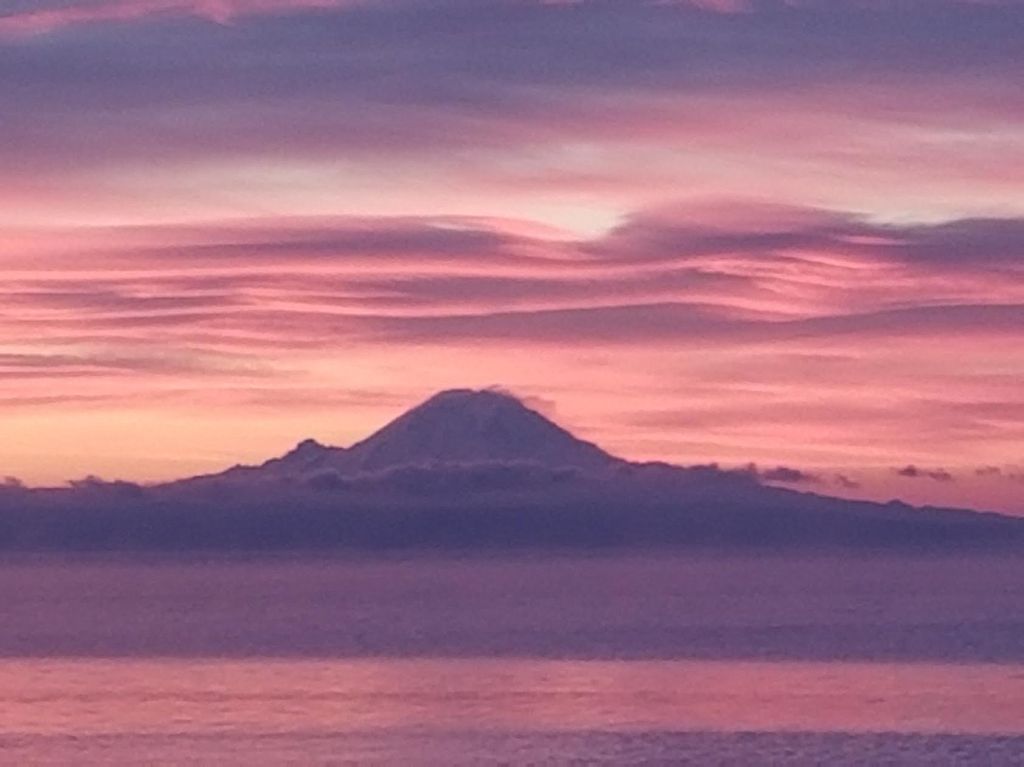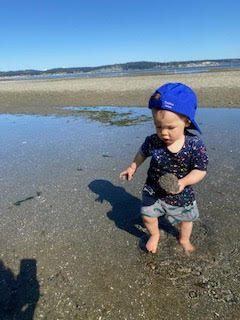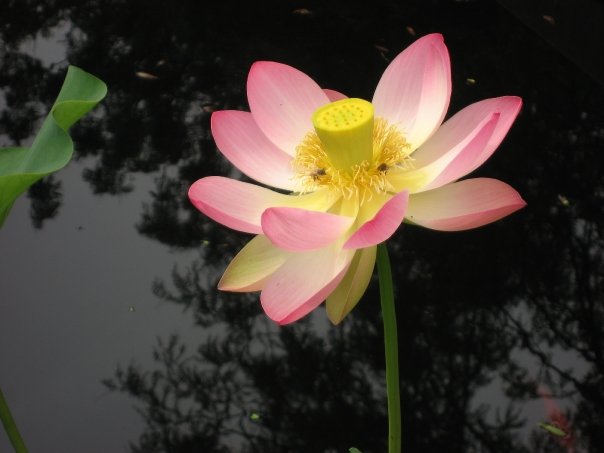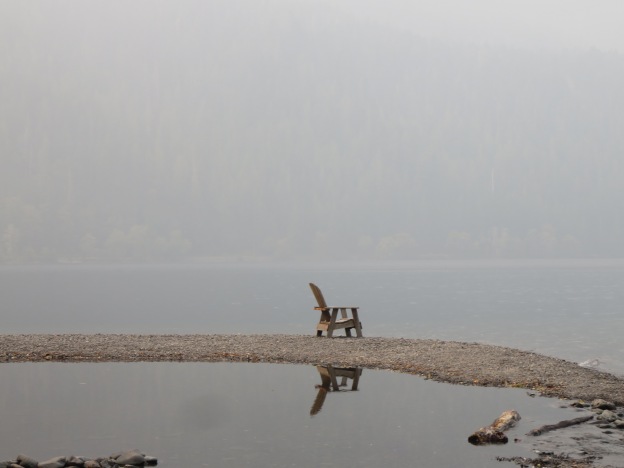GONE FISSION
On July 1, 1946 my dad, Sgt. Frank Wolf, sent a letter to his grandmother from Bikini Atoll with a special postmark for that day: “Atomic Bomb Test.” “Be sure and save this envelope,” he wrote, “as it may some day be quite a collectors’ item.”
On July 1, fifty-four years later, Dad died of a type of cancer associated with radiation exposure. And in July of 2013, I received a letter informing me that the U.S. government would be sending a check to me and my siblings in compensation for our father’s exposure to nuclear fallout.
Dad was what we’d nowadays call a nerd. A skinny guy, his nieces and nephews called him Uncle Peewee. To his math students, he was Professor Wolf. We four kids just knew him as Dad, the one who got us up early to go fishing and who couldn’t resist a bad pun.
He took keen interest in his work as an engineer in the Army’s technical division, producing U-235 from uranium—even if he was kept in the dark about WHY he was doing it. Stories of the U.S. atomic weapons project came out after the fact—from Enrico Fermi’s first self-sustaining nuclear chain reaction at the University of Chicago, until the first successful test of the bomb three years later. Terms like “nuclear fission” were coined by scientists as they gleaned what the split atoms could do. Secret nuclear research accelerated to a hectic pace with the events of World War II.
TESTS ONE AND TWO
In July 1945, J. Robert Oppenheimer, head of the Manhattan Project, sent two of his fellow scientists a cryptic letter inviting them to join him for “our fishing trip.” They knew what he meant: the new device called the Gadget was about to go off in New Mexico.
The blast on July 16 was equal to 15,000 tons of TNT, surpassing all expectations. People in three states reported seeing the flash. Brigadier General Thomas Farrell, a close witness, admitted that when the test began, “there was in everyone’s mind a strong measure of doubt.” Its success “was a justification of the several years of intensive efforts of tens of thousands of people—statesmen, scientists, engineers, manufacturers, soldiers, and many others in every walk of life.” He called the effects of the bomb unprecedented and terrifying, yet also “magnificent.”
The success of the Manhattan Project in producing and detonating its astonishing gadget meant it could then be used in warfare. The atomic bomb let loose on Hiroshima, Japan was essentially the second trial of the new technology.
My husband’s cousin, Reiko, lived in Hiroshima. She was at her desk on the morning of August 6, 1945 when the bomb fell. She was eight-years-old. The other third-graders rushed to the window to see what caused the big, white flash. Reiko did not look up from her schoolwork until the glass in the window shattered. As the atomic cloud swelled over Hiroshima, tens of thousands of her fellow citizens were already dead. 100,000 more were injured, including many of her classmates. Almost half of the 320,000 people of Hiroshima would die from the effects of the bomb by the end of the year.
Reiko walked to her home on the outskirts of the city. She and her mother went out in the evening and took food to the ash-covered people fleeing the devastation.
TESTS THREE AND FOUR
The next use of the atomic bomb was three days later in Nagasaki, causing more devastation and killing more than 70,000 people. On August 15, Emperor Hirohito announced the surrender of Japan.
The fourth use of an atomic bomb was the one celebrated with the special postmark on Dad’s letter, after the War. Four days later, at a Paris fashion show, a new swimsuit named after the bombsite debuted: the bikini. A cartoon series depicting the atomic age of 2062 was developed called “The Jetsons,” imagining a tricked-out, high-speed world of the future: a hovercraft in every carport, a robotic maid in the kitchen.
Having worked at Oak Ridge laboratories for the Manhattan Project, Dad wanted to see the uranium-fueled technology in action. For that fourth test, he was watching from the U.S.S. Haven beyond the lagoon. With the lightning-bolt insignia of the Special Engineering Detachment on his shoulder, Dad must have felt part of the power surge carrying America into a new age, ready to apply his training. He got his chance when he was assigned to be a radiation monitor for the next test in the lagoon of Bikini Atoll.
TEST FIVE: A MAJOR MISTAKE
Dad wrote about that day, “It was an interesting mix of people in the Radiological Safety Section. My particular team of radiation monitors consisted of a Major from the Army Field Artillery, myself, and two others. The Major was appointed senior monitor.” This appointment, Dad told us, was based on rank and not expertise. The Baker explosion (click to see photos and video) was detonated underwater in the Bikini lagoon at 8:35 on the morning of July 25, 1946. Two hours later, my dad and his team entered the lagoon in their small landing craft, accompanied by a gunboat. They had a Geiger counter and an ion chamber for measuring radiation.
The team headed for the middle of the lagoon, keeping their eyes on the Geiger counter. Dad noticed, “As we got closer to the target center the readings went up. Then rather suddenly they dropped to almost nothing. I told the Major I thought we might be in heavy radiation. He looked at the dial on the counter and said that I must be mistaken since the needle was at zero. As we headed closer to target center, I decided that this was not the time to explain how Geiger counters work, ignored the Major, and went to the cabinet in the rear and got out the ion chamber.”
Radiation levels were actually beyond the capacity of the Geiger counter to measure. When Dad got the ion chamber set up, its needle climbed and kept on climbing. The Major saw they were in radioactivity ten times above the recommended limit and ordered the landing craft and gunboat to get out of there.
“We headed back to the entrance of the lagoon as fast as we could go,” Dad wrote. Their boat, it was found later, was so contaminated from radioactive fallout it could not be used again.
My father, in his youth, was optimistic about the possibilities of the Atomic Age. As he grew older and worked for peace and environmental causes, he would have agreed with Enrico Fermi who said that scientific advances have certainly “led to technical and industrial applications that have revolutionized our way of life. […] What is less certain, and what we all fervently hope, is that man will soon grow sufficiently adult to make good use of the powers that he acquires over nature.”
We now know the horrifying consequences of nuclear warfare and can, with maturity, wisdom and united effort, prevent its use in the future. May we make good use of the knowledge and powers we’ve acquired and work together for a healthy, beautiful world.

News of Dad at Bikini Atoll






























